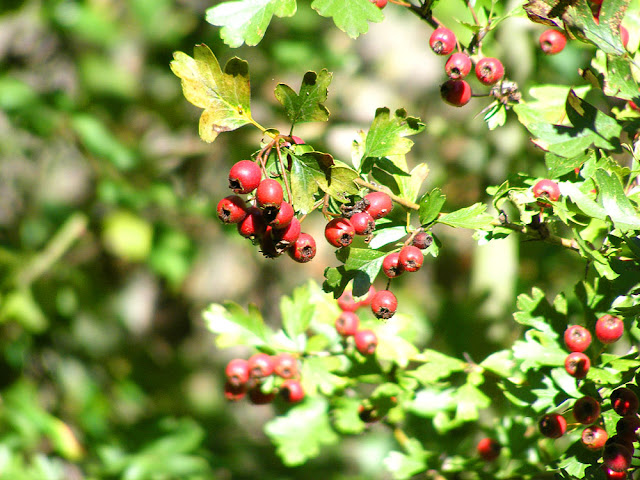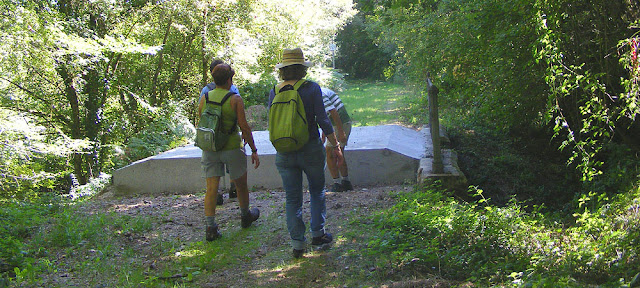 |
A two chateaux view with pear trees.
|
At a certain point up on the heights above the River Claise you can see both the medieval chateaux of Le Grand Pressigny and Etableau. [Le Chateau d'Etableau] Once there would also have been the chateau of Chanceaux nearby (behind me as I took this photo) but it has long ago completely disappeared but for some earthworks in the forest. [Walking Around an Invisible Chateau]
The point from which I took the photo is a landscape full of pear trees, wild in the hedgerows, along the road and in small household orchards. They were loaded with fruit, falling on the road to be squashed, but woody and hard in the mouth. If I understood the discussion about them correctly, they were used as a source of sugar to sweeten wine, in the days when your wine was stored in barrels, and frequently went off (ie turned to vinegar) before you had made the next vintage. If eaten they were always cooked, but they don't seem to have been used for poire williams type eau de vie or to make perry (Fr. poiré), the pear version of cider. The best known local pear delicacy is poires tapées, pressed dried pears, usually eaten as a condiment for game.
 |
A salt smugglers' hideaway.
|
We passed a pair of ruined buildings which I'd never seen before. They are off the side of a track which links two others along a small valley. I've walked both the other tracks before, but never this one that links the two. The buildings were once a hideout for salt smugglers I'm told, on the site of what had been a subterranean refuge in the Middle Ages. I didn't venture too far off the track. The ground dropped away very sharply near the ruined gables, and there was a grate over a hole that might have been a well or maybe a collapsed ceiling of the underground tunnels. There was a sign saying the place was dangerous.
The Touraine was one of the areas in France where salt was heavily taxed (the notorious gabelle), so there was an active black market. [The Salt Store -- le Grenier à Sel] According to what I was told, the requirement by law for salt in bread was the main problem. I had already read about the fact that we are in an unsalted butter area because it was an unnecessary expense. Discussing it with Simon later we realised that there isn't much of a tradition here of salt curing meat either. Pork and poultry is preserved by slow cooking and storing it under a layer of fat in your cellar. The cool temperature combined with the anaerobic conditions in the storage jar keep the meat safe indefinitely. Beef and lamb is consumed more rarely, and fresh.
 |
Nettle-leaved Bellflower Campanula trachelium (Fr. Campanule gantelée).
|
 |
The Claise River at Le Grand Pressigny.
|
 |
Hawthorn Crataegus monogyna (Fr. aubépine).
|
 |
Cyclamens naturalising in the forest, from the private park around the chateau de la Vienne.
|
 |
Spindle Euonymus europaea (Fr. fusain).
|
 |
One end of a longère style building, where people lived one end and animals the other, in a hamlet.
|
 |
Sloes and rose hips in the hedgerow.
|
The twittering and rustling in this hedge and the small orchard behind it had to be heard to be believed. It turned out to be a flock of starlings, no doubt stuffing their faces with all this autumn bounty.
 |
A new bridge along the Sud Touraine Greenway.
|
We were pleased to see that work on the Greenway (Fr. voie verte), which will create a walking and riding trail out of the former railway line between Descartes and Tournon, has not entirely stalled. [Funding for the Greenway]
 |
Walking along the Sud Touraine Greenway.
|
************************************************
For details of our private guided tours of chateaux, gardens, wineries, markets and more please visit the
Loire Valley Time Travel website. We would be delighted to design a tour for you.
We are also on
Instagram, so check us out to see a regularly updated selection of our very best photos.












2 comments:
Lovely photos.
In my days, I would have enjoyed such a walk with so many different things to see.
In the photo of the Claise, what are those three white spots in a row? Water lilies? The flow of the river seems to be very slow to let all this vegetation to take hold.
The vegetation is all aquatic and a sign the river is healthy. This is some of Yohann the river techician's best work. The flow is quite rapid here because it's shallow. The white spots are little patches of water crowfoot flowering from memory.
Post a Comment